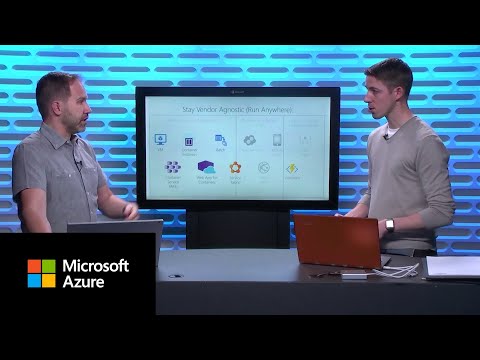The Device Chronicle interviewed Azure developer and Azure MVP Barry Luijbregts to find out about the importance of Azure IoT Hub projects, and the business ecosystem as a whole.
Barry’s focus is on the complete Microsoft technology landscape and on Microsoft Azure in particular. He has been working with the Azure cloud since its inception and he tries to keep up with it every day. He believes that the cloud can enable the software industry to mature by not having to reinvent plumbing, but to focus on building things that add value. Barry is also the author of three key books on Azure development including “200 Things Developers Should Know”, “The Developer’s Guide to Microsoft Azure”; and “How to troubleshoot Azure Web Apps”. The latter is only available in Dutch. He took some time to give us the lowdown on the importance of Azure in the IoT ecosystem and he also shared his thoughts on interesting IoT use cases, OTA software updating and IoT cybersecurity.

Starting out with Azure
Barry explains that the first major benefit of using Azure for IoT projects is its modularity where components can be clicked together to build a comprehensive IoT solution. He says “With the types of services in Azure such as Azure IoT Hub, it becomes easier and therefore organisations can just on-board their IoT devices and get value.”
Greatest benefit of Azure IoT Hub
Barry believes that Azure IoT Hub brings its greatest benefit when it’s used in organizations of greater scale. He says “The cost-effectiveness of Azure IoT Hub definitely shines when you use it at scale, you can obviously use it at the smaller scale as well. But they’ll be more difficult because obviously you have the cost of creating and implementing the IoT solution with engineers and developers tying it all together by provisioning devices. So it really only becomes cost efficient when you have larger numbers there.” What Barry means with cost-effectiveness is that it actually justifies the costs of using a device or infrastructure like that and an IoT solution like that and actually making back the money having a return on investment on. Users already have access to other Microsoft tools such as Microsoft 365 and have access to Power Bi, with which they can visualize the data for instance. So for business users, it’s an easy crossover because they can easily get to the data. This is sometimes harder to do when you have it in other public IoT clouds because they need to do an extra process to get the data to some database or some intermediate thing, which users can then access through their other dashboards.
Data in the Azure engine providing business insights
For Barry the power of Azure is that it’s all data in an engine for reuse. Azure IoT hub itself doesn’t really have an analytical engine, it is a pass-through service. So the user gets data and then they say where do they want this data to go? And how do they want to transform it a little bit more with a filter? And with that, they can send it as functions to a database for instance. For instance, you can send it to Azure IoT Time Series. This is a database structure specifically made for this type of data time-based data. Which then, on top of it, has its own visualization, analytical engine, all of that stuff, obviously works with the normal suite. Power BI and Excel, for instance, plugs into there. One of the advantages is once the user has the data in one of Microsoft – let’s say a standardized data system like for instance your SQL database – then they can just ship it or connect it to anywhere. APIs allow connections to all the parts of the Microsoft ecosystem so the IoT data can be connected to Microsoft 365, Power Apps, Dynamics CRM and so on.
Barriers to adoption of IoT
Barry steps back and looks at the broader landscape for IoT adoption. He says “For companies to adopt IoT, it can be difficult because they need real-world devices and things that run on these devices, and this often requires the skills of embedded engineers and the development of things in C++ and so on. These embedded professionals are hard to find.” He continues to say that from a business perspective, companies want to get into the IoT space. Companies know that there is value to be created from investments in IoT, but some failures to learn from in a nascent market must also be faced and absorbed. “It is reminiscent of Big Data 5 years ago, everybody knew that they needed to go into that space, but it was difficult to get started. Where do you look, where do you get people and expertise to actually do that?”
Impactful IoT use cases
Barry points to the most interesting use case that he has seen in IoT. He describes an organisation that had a fleet of vehicles (kept anonymous for project confidentiality reasons). He says that there were all sorts of vehicles that were running around large areas either within the agricultural or within the logistical space and they had all these tiny IoT trackers that were installed in these machinery. The trackers could see the location of the vehicles, and detect speed and occupancy. Is there somebody in the machine managing the machine right now or not? How full is the battery charge in the machine? Then depending on the device on devices were diggers that were digging sand, for instance. There were also specialized trackers that could then track how full is the digger thing itself when it does one bigger movement so that you can estimate the volume of material being moved and all that together then gives deep insight into the efficiency of the devices as in how many times, and how much are they utilized? How much are they meant? Do they actually operate for the purposes they were purchased for? Which then very quickly gave an overview to the managers and people that bought and maintained these things too. Then being able to answer questions such as do we need to buy another machine or making stakeholders aware that they are in fact only utilizing 60% of the things that we actually have so maybe we can just get rid of a couple of them and then utilize them more effectively. That’s IoT providing incredible cost saving right there with just a simple insight that you would otherwise not have.
Growth of the Digital Twin
With IoT devices, the promise is as Barry explains, is how you can design your physical world within a digital world. He says “So you make twins of buildings and devices and vehicles, and people as well. I think the biggest advantage of having digital twins is that you can actually visualize where things are going. So for instance, in the example that I mentioned earlier where you have devices or vehicles and people entering in and out of locations zones or geo zones, now you can actually visualize it so that you can see where these devices actually are in real time. So for instance, if you have delivery trucks, delivering things to people like Amazon packages or whatever, you fit those trucks with IoT trackers and you have a digital twin of the device, then you can see your whole fleet on. Let’s say a map of a country or an area in a country and then you can actually see in real-time where all these things are. Another one would be that you could model a building or an office and see how an office and the devices within the office. How do the temperature sensors behave? When there are things that happen such as people coming through devices coming through vehicles, coming through temperature raises and, and falls throughout the day naturally. Now, you can simulate how that actually works. It’s still relatively early days with digital twins and the designing capabilities of services to actually design that digital environment, but we’re definitely getting there. You see in Azure Iot Central and IoT Hub, you have this device simulator as well, and you can then simulate digital devices without actually having a physical device. And that helps a lot when you get started and you haven’t, you don’t have any connections yet to the actual real world. And then you can start to design your iot infrastructure basically with digital twins and then connect that to the real world.
Importance of OTA software updates
Barry believes that OTA software updates are absolutely necessary because you know the IoT devices are the next big thing in Internet security flaws. When you have a big IoT infrastructure with all of these little devices that all have their own operating system versions which might have security flaws. For instance, if an application is running on top of those which have the same, you need to be able to update that whenever you find something or whatever, the manufacturer updates the OS, you need to do that quickly. And that means that you can’t just get all the devices back or code physically to the devices, and then update them. So, you need it, you need a central place, where you can just press the button and do that. That’s absolutely vital, otherwise, through all of those little endpoints are ways into your infrastructure and into your company – that’s devastating if we don’t have that.
IoT cybersecurity
Enterprises are just becoming aware of things like ransomware. These are obvious things that have been around for years but are now becoming way more prevalent for businesses and business owners. There is an entrenched mindset that this doesn’t happen to us, it happened to that other company. The general business audience may also have the perception that where you have an IoT infrastructure, then it is very high tech and when you have something like that because it seems so futuristic then it’s probably not really hackable. It’s probably very secure people that created and invented this stuff probably thought of this very very deeply and therefore it’s probably very secure obviously. It’s not because it’s just software that developers write and they do make mistakes. So we need to be able to correct those mistakes, with tools such as OTA software updates. I do hope the awareness of this need grows. Barry believes that more bad news will probably increase that awareness of the need for properly updated software to prevent breaches. “So whenever we see big security breaches in IoT infrastructures for instance that impact real people, that will increase the awareness of this issue.”
Barry is a PluralSight author and creates courses for the Pluralsight online learning platform. He has created many courses about many topics, including HTML, JavaScript, CSS, CI/CD, WebAssembly, Azure, .NET, and ASP.NET Core. Follow Barry on Pluralsight to get a notification of his new courses and course updates.
Follow Barry on Twitter
OTA software updates solution Mender.io has a reference integration with Azure IoT as the ideal complement for providing OTA software updates at scale.
A new updated integration between Azure IoT Hub and Mender is scheduled for release in January.
